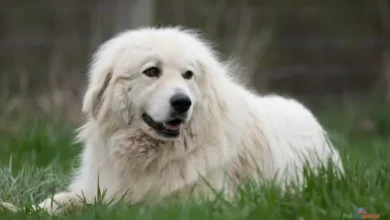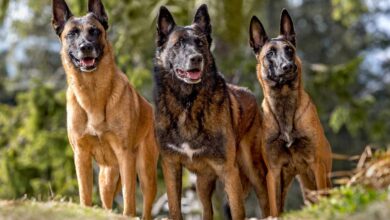
Waghound.com is an Amazon Associate, and we earn from qualifying purchases.
Meet the Great Pyrenees Pitbull Mix—a unique blend of strength, loyalty, and gentle charm. This hybrid breed combines the fearless heart of the American Pitbull Terrier with the calm, protective nature of the Great Pyrenees. Often called a Pyrenees Pitbull or Pitenees, this mix is gaining popularity as a devoted family companion and reliable guard dog. Whether you’re drawn to their striking appearance or their loving personality, understanding this hybrid’s needs is key to a happy life together.
Imagine a dog that watches over your home like a gentle giant but greets your family with endless affection. The Great Pyrenees Pitbull Mix offers exactly that. Thanks to its parent breeds, this dog inherits the Pitbull’s playful loyalty and the Pyrenees’ natural instinct to protect. However, their strong personality and size mean they thrive best with owners who can provide proper training, space, and care.
In this guide, we’ll explore everything from their guard dog capabilities to their family-friendly traits. You’ll learn how to manage their energetic spirit, maintain their thick coat, and address common health considerations. Whether you’re a first-time dog owner or experienced with hybrids, this article will help you decide if the Pyrenees Pit Mix is the right fit for your home. Let’s dive into the world of this remarkable crossbreed and uncover what makes them such unforgettable companions.
Breed Overview
The Great Pyrenees Pitbull Mix is a cross between two popular breeds: the gentle giant Great Pyrenees and the loyal American Pit Bull Terrier. This mix, often called a Pyrenees Pit or Pitenees, blends the Pyrenees’ protective nature with the Pitbull’s playful spirit. While not an official breed, these dogs are loved as family pets and home guardians.
Origin and History of the Mix
The Great Pyrenees Pitbull Mix likely started in the U.S. in the 1900s. Breeders wanted a dog that could guard homes like the Pyrenees but bond closely with families like Pitbulls. The goal was to create a loyal protector that’s also great with kids.
Designer dog trends helped this mix grow in popularity. Since the 1980s, people have mixed purebred dogs (like Labradors and Poodles) to get specific traits. The Pyrenees Pit fits this idea—it’s bred for strength, loyalty, and a calm personality.
Today, these dogs are most common in the U.S. You’ll find them in shelters or through breeders who focus on mixed breeds.
At a Glance: Quick Facts Table
| Category | Details |
|---|---|
| Size | 22–27 inches tall (as tall as a kitchen counter!) |
| Weight | 60–100 pounds (like a medium-sized adult human) |
| Lifespan | 9–15 years (longer than many large dogs) |
| Coat | Short or long; some have a thick, fluffy coat like the Pyrenees |
| Job | Family friend and home protector |
| Personality | Loyal, brave, loves family, cautious with strangers |
| Breed Status | Not an official breed; considered a mixed dog |
Parent Breed History and Characteristics
To understand the Pyrenees Pit Mix, let’s meet its parents—two breeds with very different jobs but big hearts.
The Great Pyrenees Legacy
The Great Pyrenees (or Pyrenean Mountain Dog) has guarded sheep for over 1,000 years. They come from the Pyrenees Mountains between France and Spain. These fluffy giants protected flocks from wolves and bears using their loud bark and strong presence.
What they look like:
- Huge size (85–140 pounds)
- Thick white or gray fur (like a living snowdrift!)
- Gentle eyes and a calm face
Personality:
- Naturally protective but calm at home
- Independent thinkers (they like to make their own rules sometimes)
- Great with kids and other pets when trained early
American Pit Bull Terrier Background
Pitbulls have a misunderstood past. Bred in 1800s England for bull-baiting (a cruel sport now banned), they later became farm helpers in America. Farmers loved them for their strength and loyalty.
Myth vs. Truth:
- Myth: Pitbulls are naturally aggressive.
- Truth: With love and training, they’re affectionate family dogs.
What they look like:
- Muscular body (40–70 pounds)
- Short, shiny coat in colors like brown, black, or brindle
- Big smile that shows their happy nature
Personality:
- Eager to please and easy to train
- Loves playing and cuddling with family
- Needs daily exercise to stay happy
By mixing these two breeds, the Pyrenees Pitbull Mix gets the Pyrenees’ protective instincts and the Pitbull’s playful love—a perfect combo for active families!
Physical Characteristics of the Pyrenees Pit Mix
The Great Pyrenees Pitbull Mix is a large, strong, and beautiful dog. They inherit physical traits from both parent breeds, making them unique in size, build, and coat appearance. Let’s break it down into simple details.
Size, Weight, and Build
The Pyrenees Pit Mix is a big dog with a strong and athletic body.
- Height: They are 22–27 inches tall (about the height of a kitchen counter).
- Weight: They weigh between 60–90 pounds, depending on their diet and genetics.
Their build combines features of both parent breeds:
- From the Pitbull, they get a broad chest, strong shoulders, and a muscular frame.
- From the Great Pyrenees, they gain height, solid bones, and a sturdy structure.
Even though they are large, these dogs are agile and move gracefully. Their strength and athleticism make them great companions for active families.
Coat Types and Colors
The coat of a Pyrenees Pit Mix can vary depending on which parent they take after more.
Coat Types
- Short Coat:
- If they inherit the Pitbull’s genes, their coat will be short and smooth.
- This type of coat is easy to care for but sheds lightly all year round.
- Double Coat:
- If they take after the Great Pyrenees, they may have a long and fluffy double coat.
- This coat keeps them warm in cold weather but sheds heavily during spring and fall.
Colors
Pyrenees Pit Mixes come in many colors. Common shades include:
- Black
- White
- Red
- Fawn
- Gray
- Blue
- Brindle (a mix of stripes or streaks of color)
Some dogs may also have unique patterns like patches or spots, making them even more special.
Shedding Patterns
Shedding depends on their coat type:
- Dogs with a short coat shed lightly year-round but need weekly brushing to keep their fur healthy.
- Dogs with a double coat shed heavily in spring and fall when they lose their undercoat to adjust to changing seasons. Daily brushing during these times helps reduce shedding.
In summary, the Great Pyrenees Pitbull Mix is a large dog with a strong build and a variety of coat types and colors. Whether their coat is short or fluffy, regular grooming will keep them looking great while keeping your home cleaner!
Temperament and Personality Traits
The Great Pyrenees Pitbull Mix is a loyal, smart, and protective dog. They make great family pets but need training to be their best. Let’s break down their personality in easy-to-understand terms.
Protective Guardian Instincts
These dogs are born protectors. They get this trait from their Great Pyrenees parent. Here’s what you need to know:
- Watchdog Skills: They bark loudly to warn you about strangers or odd noises. This makes them good at keeping your home safe.
- Protective Behavior: They might guard their family, toys, or yard from people or animals they don’t know.
How to Handle Protectiveness
Teach them when to relax:
- Meet New People Early: Let them meet friends, neighbors, and other pets as puppies. This helps them stay calm later.
- Praise Calmness: Give treats or say “good dog” when they stay relaxed around strangers.
- Use Simple Commands: Teach “sit” or “quiet” to help them listen when they get too protective.
With practice, they’ll learn to protect without being overly aggressive.
Family Compatibility and Sociability
These dogs love their families deeply. They enjoy being part of daily life and need lots of attention.
With Family Members
- Affectionate: They love cuddles and will follow you around the house.
- Gentle with Kids: They’re patient with children but are big dogs—always watch them around small kids to avoid accidents.
With Strangers
- Shy at First: They might hide or bark when meeting new people. Introduce guests slowly and let the dog approach when ready.
Friendliness Ratings
- Kids: 4/5 (gentle but needs supervision).
- Strangers: 3/5 (cautious but improves with training).
Intelligence and Trainability
This mix is very smart but can be stubborn. Training takes patience but pays off!
How Smart Are They?
- They solve puzzles quickly (like figuring out how to open a gate).
- They learn commands fast but might ignore them if bored.
Training Challenges
- Stubbornness: They might pretend not to hear you if they’d rather play.
- Short Attention Span: They get bored with long training sessions.
Training Tips That Work
- Keep It Short: Train for 5 minutes, 2–3 times a day. Make it fun!
- Reward Good Behavior: Use treats, toys, or praise when they listen.
- Stay Consistent: Use the same commands every time (like “sit,” not “sit down”).
- Stay Calm: Never yell—they respond better to kindness.
With time, they’ll learn to follow rules and become well-behaved pets.
Care Guide for Your Pyrenees Pitbull
The Great Pyrenees Pitbull Mix needs regular exercise, grooming, and a good diet to stay healthy. Here’s a simple guide to caring for them.
Exercise Needs
These dogs have medium to high energy and need daily activity to stay happy.
- Daily Playtime: Aim for 1–1.5 hours of exercise every day. Try:
- Walks or jogs
- Playing fetch in a yard
- Hiking or exploring new places
- Energy Levels: They love being active but will relax at home if they get enough exercise. Without it, they might chew shoes or dig holes.
- Activity Tips: Mix physical play with brain games (like puzzle toys) to keep them busy.
Grooming Basics
Grooming depends on their coat type—short or fluffy.
Brushing
- Short Coat: Brush once a week.
- Fluffy Coat: Brush 3–4 times a week to stop tangles.
Bathing
- Bathe every 2–3 months unless they get muddy. Too much bathing dries their skin.
Nails
- Trim nails every 3–4 weeks to keep them short and comfortable.
Ears
- Check ears weekly. Clean gently with a damp cloth to prevent infections.
Shedding
- Fluffy Coats: Shed heavily in spring and fall. Brush daily during these times.
- Short Coats: Shed lightly all year. Brush weekly.
Feeding Tips
Feed them well to keep them strong and healthy.
How Much to Feed
- Give 3–4 cups of good dog food daily, split into two meals (morning and evening).
Special Food Needs
- Protein First: Choose foods with real meat (chicken, fish) to build muscles.
- Healthy Fats: Add fish oil for a shiny coat and healthy joints.
- Avoid Fillers: Skip foods with corn or wheat—they offer little nutrition.
Always keep fresh water available, especially after playtime.
Health and Lifespan of the Great Pyrenees Pitbull Mix
The Great Pyrenees Pitbull Mix is usually healthy but can face some health issues. With proper care, they can live a long, happy life. Let’s break down their health needs in simple terms.
Common Health Issues
This mix may inherit health problems from its parents. Here are the most common ones:
- Hip Problems: Common in big dogs. Their hip joints may not form right, causing pain and trouble moving.
- Elbow Issues: Similar to hip problems but affects the front legs. Can lead to arthritis.
- Bloat (Twisted Stomach): A deadly emergency where the stomach fills with gas and twists. Signs: swollen belly, drooling, restlessness. Go to the vet immediately!
- Heart Issues: Weak heart muscles (common in Pitbulls). Regular vet checks help catch this early.
- Eye Problems: Eyelids may roll inward or outward, irritating the eyes. Needs vet care.
- Skin Allergies: Itchy skin from pollen or dust. Treat with medicine or special food.
Preventative Care
Stop problems before they start with these steps:
Vaccines
- Start vaccines at 6–8 weeks old.
- Get booster shots every month until they’re 4 months old.
- Yearly shots for rabies and other diseases as your vet recommends.
Vet Visits
- Yearly Check-Ups: The vet will:
- Check weight and teeth.
- Listen to their heart.
- Test blood for hidden issues.
Daily Care
- Use flea/tick prevention monthly.
- Give heartworm medicine (prescribed by your vet).
- Brush their teeth 2–3 times a week.
Lifespan and Senior Care
These dogs live 9–15 years on average. As they age, they need extra care:
Senior Dog Tips
- Food: Switch to senior dog food—lower calories but packed with nutrients.
- Joint Help: Add fish oil or glucosamine supplements to ease arthritis pain.
- Exercise: Shorter walks and gentle play instead of running or jumping.
- Comfort: Soft beds and ramps to help them climb stairs or get into cars.
Watch for signs of aging like slower movement, trouble hearing, or weight gain. Regular vet visits become even more important for older dogs.
Training Your Great Pyrenees Pitbull Mix
Training your Great Pyrenees Pitbull Mix is important to help them grow into a well-behaved and confident dog. These dogs are smart but can be stubborn, so early socialization, clear rules, and positive reinforcement are key. Here’s a simple guide to help you train them effectively.
Early Socialization Importance
Socializing your puppy early is essential for their development. The critical socialization period is between 3–12 weeks, when puppies are most open to new experiences.
Why Socialization Is Important
- It helps them feel comfortable around new people, animals, and places.
- It prevents fear, aggression, or anxiety later in life.
- It builds their confidence and trust in you.
Easy Socialization Tips
- Start Early: Begin introducing your puppy to new things at 7–16 weeks of age.
- Make It Positive: Use treats and praise to create happy memories during new experiences.
- Go Slow: Introduce them to new sounds, smells, and sights (like vacuum cleaners or car rides) gradually so they don’t feel overwhelmed.
- Keep Sessions Short: Spend just 5–10 minutes on each new activity to avoid tiring them out.
- Meet New People: Let your puppy meet people of different ages and appearances in a calm way.
- Playdates: Arrange playdates with friendly dogs to teach good social behavior.
By exposing your puppy to different situations early on, they will grow into an adaptable and calm adult dog.
Effective Training Approaches
Training your Great Pyrenees Pitbull Mix works best with patience, consistency, and rewards.
Best Training Methods
- Use Rewards: Treats, toys, or praise encourage your dog to repeat good behavior. Reward them immediately after they follow a command so they understand what you want.
- Short Sessions: Train for 5–10 minutes at a time to keep their attention focused.
- Daily Practice: Repeat commands like “sit,” “stay,” “come,” and “leave it” every day until they master them.
- Stay Patient: These dogs can be independent thinkers, so don’t get frustrated if they take time to respond.
Common Challenges and Solutions
- Stubbornness: If they ignore commands, use extra rewards like treats or toys to motivate them.
- Boredom: Long sessions can make them lose interest—keep training fun and interactive.
- Leash Pulling: Stop walking every time they pull on the leash and reward calm walking.
With consistent practice and patience, your dog will learn basic obedience and become well-behaved.
Living With a Pyrenees Pit Mix
The Great Pyrenees Pitbull Mix is a loyal and adaptable companion. Here’s how to make your home a happy place for them, whether you have kids, other pets, or a busy lifestyle.
Home Environment Needs
Space Requirements
- Best for Yards: These big dogs (60–100 pounds) love space to play and patrol. A house with a fenced yard is ideal.
- Apartment Living: They can live in apartments if you walk them 90+ minutes daily and play brain games (like puzzle toys) to keep them busy.
Weather Tolerance
- Cold Weather: Their thick coat (from the Pyrenees parent) keeps them warm in snow and cold. They love winter!
- Hot Weather: They overheat easily in summer. Give them shade, plenty of water, and air conditioning. Avoid midday walks when it’s too hot.
Indoors, they like cool spots to rest but enjoy guarding their yard in mild weather.
Compatibility With Kids and Pets
With Children
- Gentle Giants: They are patient and protective with kids, earning a 4/5 rating.
- Supervision Needed: Their large size means they might accidentally knock over small kids. Always watch playtime.
With Other Pets
- Dogs and Cats: They can live with other pets if introduced early. Raise them together for best results.
- New Animals: Introduce new pets slowly. Reward calm behavior with treats to build positive associations.
Their guarding instincts may make them wary of unfamiliar animals, so take introductions step by step.
Jobs and Fun Activities
Natural Jobs
- Guard Dogs: They bark to warn you of strangers and protect your home.
- Therapy Work: With training, their calm nature makes them great for visiting hospitals or schools to comfort people.
Fun Activities to Try
- Hiking: They love exploring trails and carrying a small backpack (adds purpose!).
- Agility Courses: Set up jumps or tunnels in your yard—they enjoy the challenge.
- Fetch: Play fetch with a tennis ball or frisbee to burn energy.
Regular activities keep them mentally and physically healthy.
By giving them space, socializing them early, and keeping them active, your Pyrenees Pit Mix will be a happy, well-adjusted family member!
Finding Your Great Pyrenees Pitbull Mix
Looking for a Great Pyrenees Pitbull Mix? You can adopt from a rescue or buy from a breeder. Here’s how to find a healthy, happy dog for your family.
Adoption Options
Adopting gives a dog a second chance. Start with rescues for Pitbulls or Great Pyrenees mixes.
Rescue Groups to Check
- Great Pyrenees Rescues: Search groups like National Great Pyrenees Rescue or local shelters.
- Pitbull Rescues: Try Pitbull Rescue Central or Adopt-a-Pet websites.
Adoption Tips
- Visit Shelters: Check nearby shelters weekly—mixed breeds like Pyrenees Pits may pop up.
- Ask Questions: Ask rescuers about the dog’s behavior with kids, pets, and strangers.
- Prepare Your Home: Buy food, a leash, and a bed before bringing your dog home.
Adoption costs $100–$400, which often covers shots and vet checks.
Buying from a Breeder
If buying a puppy, choose a breeder carefully to avoid scams or sick dogs.
What Good Breeders Do
- Health Checks: Show proof parents were tested for hip issues and heart problems.
- Clean Homes: Raise puppies in clean spaces with playtime and socialization.
- Meet Parents: Let you meet the puppy’s mom and dad to check their health and temper.
Puppy Price
- Cost: $600–$2,500, depending on the breeder’s reputation and location.
Choosing a Puppy
- Pick playful, curious pups—avoid ones hiding or acting scared.
- Ensure puppies are at least 8 weeks old before taking them home.
Questions to Ask
Before getting your puppy, ask these questions to avoid problems.
Health Questions
- Are the parents tested for hip and heart issues?
- Are the puppies vaccinated and dewormed?
Temperament Questions
- How do the puppies act around kids or other pets?
- Have they been socialized with people?
Red Flags
- Breeders who won’t show health records or answer questions.
- Puppies kept in dirty cages or sold before 8 weeks old.
- No contract offering to take the dog back if you can’t keep it.
By adopting or choosing a responsible breeder, you’ll find a loving Pyrenees Pit Mix that fits your family. Always prioritize health and kindness over speed or low cost!
Conclusion
The Great Pyrenees Pitbull Mix is a unique blend of loyalty, strength, and affection. But owning this breed isn’t for everyone. Let’s break down what you need to know to decide if they’re the right fit for your home.
Key Traits to Consider
- Protective Nature: They’re natural guardians who will bark to alert you of strangers. Perfect for families wanting a watchdog.
- Family-Friendly: Gentle with kids and loyal to their owners, but their large size requires supervision around small children.
- High Maintenance: Their exercise, grooming, and training needs demand time and effort.
Care Requirements Recap
- Exercise: 60–90 minutes of daily activity (walks, playtime, hiking).
- Grooming: Weekly brushing (daily during shedding seasons for fluffy coats).
- Training: Early socialization and consistent, positive reinforcement.
- Health Care: Regular vet check-ups to monitor for hip/joint issues.
The Good vs. The Challenging
Rewards:
- A loyal, loving companion who bonds deeply with family.
- A natural protector who keeps your home safe.
- A playful, energetic partner for outdoor adventures.
Responsibilities:
- They need space (ideally a yard) and can’t be left alone for long.
- Their stubborn streak requires patient training.
- Potential vet bills for genetic health issues.
Who Should Get This Breed?
✅ Yes, if you:
- Have an active lifestyle with time for daily exercise.
- Want a protective family dog and are willing to socialize/train them.
- Can handle grooming and vet costs.
❌ No, if you:
- Prefer a low-energy or small apartment-friendly dog.
- Can’t commit to consistent training or have very young kids.
- Want a “hands-off” pet that doesn’t need much attention.
In the end, the Great Pyrenees Pitbull Mix is a devoted and courageous companion for the right owner. If you’re ready for the responsibility, they’ll reward you with unwavering loyalty and love. But if you’re unsure about the commitment, consider a lower-maintenance breed. This mix thrives in homes where they’re treated as family—protected, loved, and given purpose.
Final Tip: Visit a rescue or breeder to meet the dog in person. Seeing their personality firsthand can help you decide if they’re your perfect match!
FAQs
Are Great Pyrenees Pitbull Mixes good guard dogs?
Yes, they are excellent guard dogs. Their protective instincts make them natural watchdogs, and they will bark to alert you of strangers. Early training helps them distinguish between real threats and harmless visitors.
How big do Great Pyrenees Pitbull Mixes get?
These dogs typically weigh between 60–90 pounds and stand 22–27 inches tall. Their size makes them strong and sturdy, so they need enough space to move around comfortably.
Do Great Pyrenees Pitbull Mixes shed a lot?
It depends on their coat type. Dogs with a double coat (like the Great Pyrenees) shed heavily, especially during spring and fall. Those with a short coat (like the Pitbull) shed lightly year-round. Regular brushing helps manage shedding.
Are they good for first-time dog owners?
They can be challenging for first-time owners due to their size, energy, and stubbornness. However, with proper training, patience, and commitment, they can be a rewarding companion for new owners willing to learn.
How long do Great Pyrenees Pitbull Mixes live?
They have an average lifespan of 9–15 years, depending on their overall health and care. Regular vet check-ups, a healthy diet, and exercise can help them live longer.
Do they bark a lot?
Yes, these dogs tend to bark, especially if they sense something unusual. This behavior comes from their Great Pyrenees parent, who is known for being vocal as a guardian dog. Training can help reduce excessive barking.
Can they live in apartments?
While they can adapt to apartment living with enough exercise (60–90 minutes daily), they thrive best in homes with fenced yards where they have space to move freely.
Are Great Pyrenees Pitbull Mixes aggressive?
No, they are not naturally aggressive but are protective of their family. Early socialization and consistent training ensure they are friendly with people and other animals while maintaining their guarding instincts.



